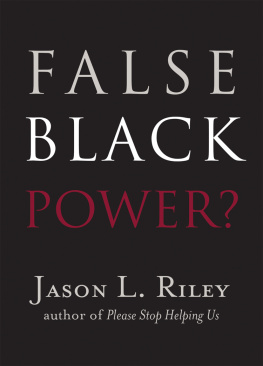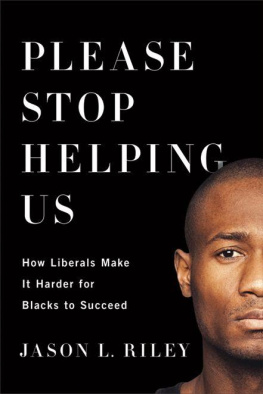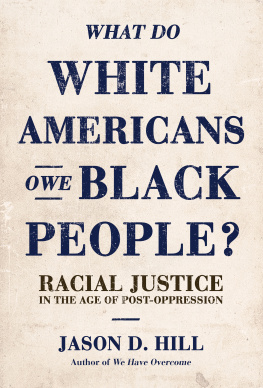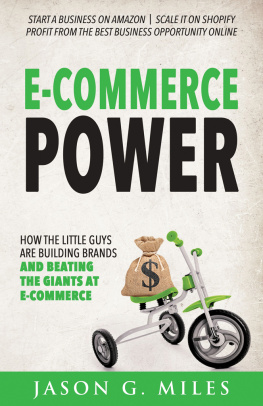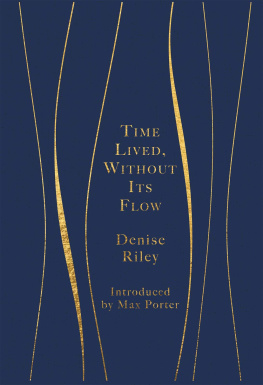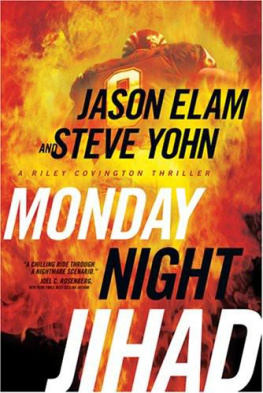Templeton Press
300 Conshohocken State Road, Suite 500
West Conshohocken, PA 19428
www.templetonpress.org
2017 by Jason L. Riley
All rights reserved. No part of this book may be used
or reproduced, stored in a retrieval system, or transmitted
in any form or by any means, electronic, mechanical,
photocopying, recording, or otherwise, without
the written permission of Templeton Press.
Designed and typeset by Gopa & Ted2, Inc.
ISBN 13: 978-1-59947-518-9
eISBN 13: 978-1-59947-519-6
Library of Congress Cataloging-in-Publication Data on file.
Printed in the United States of America
17 18 19 20 21 10 9 8 7 6 5 4 3 2 1
Introduction

I N 1976, HERBERT GUTMAN, a professor of history at the City College of New York, published The Black Family in Slavery and Freedom, 17501925. As Gutman explained in his introduction, the book was an extensive response to Daniel Patrick Moynihans controversial 1965 government study on the black family. Moynihan, who at the time was an assistant secretary in President Lyndon Johnsons Labor Department, asserted in his report that the the Negro family in urban ghettos is crumbling, as evidenced by the increase in single female-headed households. Recent civil rights gains notwithstanding, he observed, family composition still mattered, and the growing percentage of black children being raised in fatherless homes did not bode well for narrowing racial disparities in America between blacks and whites. Moynihans warnings about the effects of family structure on black socioeconomic outcomes were dismissed by his detractors as victim-blaming bigotry, but rising rates of violent crime, welfare use, and other social problems among poor blacks in subsequent decades would ultimately vindicate the future New York senator.
Gutmans criticism, however, was of a different and more fundamental nature. The Moynihan report rooted this black family disorganization in slavery and Jim Crow, experiences that supposedly had undermined the position of men in poor black households and made matriarchal black families the norm. It was by destroying the Negro family that white America broke the will of the Negro people, wrote Moynihan. This analysis essentially was a rehash of consensus scholarly thought at the time. The black sociologist E. Franklin Frazier, from whose writings Moynihan borrowed heavily, had made very similar arguments decades earlier in his 1939 study, The Negro Family in the United States. W. E. B. Du Bois and Kenneth Stampp were other prominent scholars who also had blamed white racism for the demise of two-parent black families. Nevertheless, Gutman argued that this popular thesis was deeply flawed, and his book set out to rebut it empirically.
Our objective was simple, wrote Gutman, whose initial research was conducted with fellow historian Laurence Glasco. If enslavement caused the widespread development among Afro-Americans of a fatherless matrifocal [mother-centered] family sufficiently strong to be transmitted from generation to generation, thereby affecting the beliefs and behavior of descendants of eighteenth-century African slaves who lived in mid-twentieth-century northern urban ghettos, such a condition should have been even more common among urban Afro-Americans closer to the time of slavery.
Yet thats not what the evidence indicated. After reviewing Confederate plantation records, census forms in various cities and counties in the North and South, interviews with ex-slaves, and other material, Gutman and Glasco determined the following: during slavery, its immediate aftermath, and on through the first quarter of the twentieth century, the vast majority of black children were raised in two-parent households; black marriages were as long lasting and stable as the marriages of economically comparable whites; and the black female-headed homes that did exist tended to be, like their white counterparts, comprised of older widows, not teenagers raising children alone.
Gutmans study of the black community in Buffalo, New York, from the 1850s through the 1920s, for example, showed that the double-headed kin related household always was the characteristic Buffalo Afro-American household, ranging from 82 percent to 92 percent. A broader examination of data on southern rural and urban black households only confirmed the Buffalo study. Gutmans findings demonstrated that blacks living in big cities had similar cultural patterns. An examination of 13,924 black families in New York City in 1925 revealed that 85 percent were two-parent homes, more than 80 percent of children under age six lived with both parents, and fewer than 8 percent of the households surveyed featured male-absent families headed by women between twenty-five and forty-four years old.
Gutmans pioneering research offered empirical evidence that the family structure and culture we see among poor blacks today is an outgrowth of something more recent than black bondage and legal segregation. The reality is that single parenting was rare among blacks in earlier times, even in the antebellum South. The social pathologies manifest in black ghetto communities after World War II were born of other factors, despite wide speculation that the institution of slavery was primarily to blame. Yet, more than four decades after the publication of The Black Family in Slavery and Freedom, Gutmans findings remain mostly ignored by scholars, elected officials, policymakers, and commentators who are invested in the notion that slavery and Jim Crow offer satisfactory explanations of dysfunctional black behavior in the twenty-first century. And with too few exceptions, social scientists cowed by political correctness are still downplaying or denying the strong connection between black poverty and black family structure.
In the pages that follow, I argue broadly that the current focus on white racism and political solutions to racial gaps continues to miss the mark. Our national discussions spend ample time on the impact of slavery but precious little on the black social and economic trends that followed the growth of the modern welfare state. In the postslavery era, the differences in black progress before and after the Great Society interventions are glaring. When intact families were commonplace, the rise in black education, incomes, and occupations was significant and steady. As black family disorganization intensified and wealth-transfer programs grew in size and scope, that progress slowed in some cases and stalled in others. Liberals have attempted to compensate for black cultural retrogression since the 1960s with increased black political power. In 2008, America elected her first black president, and eight years later, one undeniable lesson was that political clout is no substitute for self-development.

I AM INDEBTED to Susan Arellano of Templeton Press, who initiated this book and helped in shaping the material. I also thank the Manhattan Institute, where I am a senior fellow and have the time and freedom to explore issues with the support of dedicated colleagues who are far more interested in finding truth than being popular. Finally, I am grateful to the Thomas W. Smith Foundation, the Searle Freedom Trust, and the Dian Graves Owen Foundation, whose generosity makes my work possible.






